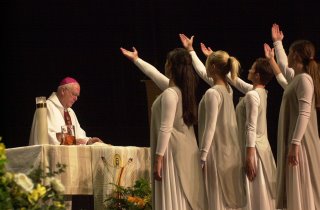
Yesterday's chapel service for grades K-8 was a demonstration of the thesis: "You can't dance to good liturgy."
Our Eastertide chapel liturgy includes an "Easter Canticle" which is the song "This is the Feast of Victory for our God" from Lutheran Worship's Divine Service II (which in turn is copied from the Evangelical Lutheran Church in America's hymnal, Lutheran Book of Worship).
Although this canticle has become a beloved staple of Lutheran worship services since the 1980s, I've never liked it. I prefer to stick by the ancient and traditional Gloria in Excelsis ("Glory Be to God on High") as the Hymn of Praise in the Sunday liturgy.
To be sure, "This is the Feast" is a biblical canticle (known by its Latin name, Dignus est Agnus). Well, most of it is, anyway. The actual refrain and title of the song isn't scriptural. And it isn't without theological problems. Is Holy Communion a feast "for" our God, a party we put on for Him? In fact, several of the "canticles" in Lutheran Worship (and the Lutheran Book of Worship) aren't really canticles at all, since they are devoid of scripture (e.g. "Let the Vineyards be Fruitful" and "Thank the Lord and Sing His Praise").
 But my meanderings for today have nothing to do with our modern-day tinkering with the Mass, or with the issues of the wording of extra-biblical canticles or parts thereof. Today I'm addressing the musical setting.
But my meanderings for today have nothing to do with our modern-day tinkering with the Mass, or with the issues of the wording of extra-biblical canticles or parts thereof. Today I'm addressing the musical setting.Back to my chapel service for the kids.
A kindergarten girl was sitting in the front pew. As we began to sing "This is the Feast," she got down onto the floor and began to "perform" the song, emoting like an American Idol contestant, complete with facial expressions and arm gestures. One could not help but smile. She meant no disrespect to our Lord and His holy sanctuary, she was just reacting naturally, and I believe this little girl's impulsive act reveals something about our liturgical state of affairs in modern American Lutheranism - not unlike the little boy who pointed out the king's nakedness. Out of the mouths of babes...
This little girl taught me something: you can't dance to good liturgy.
"This is the Feast" sounds a lot like a showtune, like a piece from a gaudy Broadway play. It is sing-songy and "dancy." It is syncopated and repetitive (the part that is repeated is, interestingly, the part of the song that is unscriptural, the part that focuses on what we are doing instead of the gifts being given to us in the Feast).
Now, had our liturgy avoided this move from traditional chant to modern sing-song, would this little girl have done the Spice Girls show during worship? I doubt it. The equivalent piece in the older Lutheran Hymnal (1941) is a setting of the Gloria in Excelsis sung in a variation of Anglican Chant (which is actually credited as a Scottish Chant in the Anglican Book of Common Prayer). You can't really dance to it, so I believe it is superior in terms of liturgy.
Can you imagine if we had been chanting a Gregorian version of Dignus est Agnus? I cannot imagine anyone listening to such a thing and feeling the urge to "shake one's booty" like Beyonce or Eminem. Again, you can't dance to good liturgy.
[Note: The other advantage to chant is that no tinkering with the sacred text to make it rhyme or make the syllables come out is necessary. Gregorian Chant is a WYSIWYG expression of the Bible ("What You See Is What You Get") - unlike, for example, the Lutheran Worship version of the Sanctus which has to translate "Sabaoth" (which means literal, physical "hosts" or "armies") into the vague and non-physical "pow'r and might" - which is a very weak and unsatisfying translation - all for the sake of musical fit. With chant, the text reigns supreme - no monkeying necessary. It reflects a high view of Holy Scripture, unlike modern "contemporary" liturgical settings.]
 Maybe the Commission on Worship (also known as the Sacred COW) was onto something in suggesting that the new Lutheran hymnal project needed a lot of "field testing" and "feedback" from the congregations. Perhaps we should sing proposed liturgical settings with a "test congregation" of kindergarten children, and if they dance, that setting is out.
Maybe the Commission on Worship (also known as the Sacred COW) was onto something in suggesting that the new Lutheran hymnal project needed a lot of "field testing" and "feedback" from the congregations. Perhaps we should sing proposed liturgical settings with a "test congregation" of kindergarten children, and if they dance, that setting is out.I think that might actually work!

8 comments:
Amen to this post. I have never liked This is The Feast. The tune is so . . . simple, so sappy. Even though it's been yrs since 1978, the congregation is still never sure whether to sing "fooooor the laaaaaamb who was slain" or "siiiiiing with all the peeeeeeeople of God" -- making for an awkward, hesitant, monotonous canticle. Combine that with an organist who plods along very slowly and it can be a real mess.
Hm, I've never gotten that impression from "This is the Feast". I've always rather liked that one, actually. Which setting are you using? Flipping through my hymnal there are two settings, the one my church uses, and the other one which I've never heard but I can tell is quite ghastly. (Granted, I'm using the LBW. Go ahead and throw rocks at me.)
When I was at the seminary, Dean Dan Reuning changed the words to "This is the Feast of Victory *of* our God..."
Now, is that a subjective or an objective genitive?
Dear PMS (Poor Miserable Sinner - sorry, I couldn't resist...), this is a very similar sentiment as Peter expressed, that "bad" liturgy is better than "worse" liturgy, and "worse" liturgy is better than "no" liturgy. Isn't it a shame that in matters of liturgy we're reduced to the "lesser of two evils" approach?
I know what you mean, for if I'm on vacation and wander into an LCMS church, I'm forced to be grateful if I find a church that uses the hymnal at all. It's kind of like a woman being grateful that her husband only hits her with an open hand and not a closed fist. It just seems like lowering the bar of expectations isn't the right way to go here.
I don't know what the answer is, I'm just throwing out thoughts and opinions. And they're worth just what you're paying for them. ;-)
Thanks for your comment!
Aaron, I filled in for a pastor whose congregation has this hymnal. But he was able to limit their use to occasional hymns. The liturgy (and everything else) in this hymnal is wretched - a far cry from what is really sung in Lutheran churches in Africa.
Can you believe Peter has foiled our plans? He has discovered our organization, the Curmudgeons and Scolds of America (CSA). Now our plot to take over the LCMS in an agrarian coup and make it the 14th Confederate State has been foiled. Drat, drat, and double drat!
We really need to do a better job in our conspiratorial activities. ;-)
Maria:
The LW uses two of the three LBW settings. I've never heard a version that sounds like dignified church music. I know you disagree, but why would I throw rocks at you? I appreciate your taking the time to comment.
What is REALLY strange is singing "This is the Feast" and not celebrating Holy Communion. I mean, what's a feast without food?
Favorite Apron:
Sometimes I think organists who play s-l-o-w-l-y pulled wings off of butterflies as kids. They are Hannibal Lechters who wear slippers.
At least play "This is the Feast" as it was written to be played. Playing like a dirge doesn't make it respectable, it just makes it interminably ponderous and painful.
"This is the farce of misery as I age. Oh play fa-a-ster!"
Post a Comment